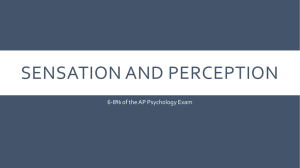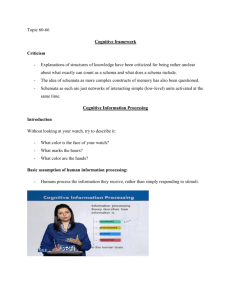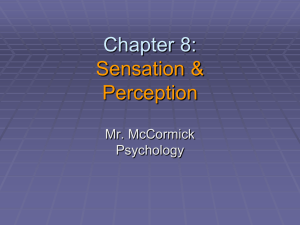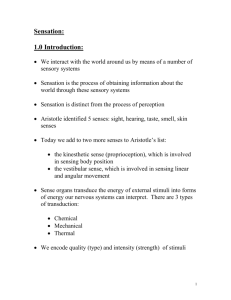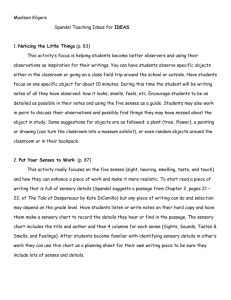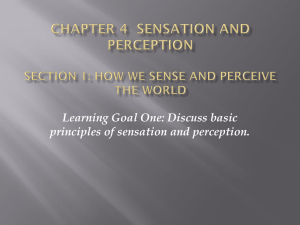Sensory Adaptation
advertisement
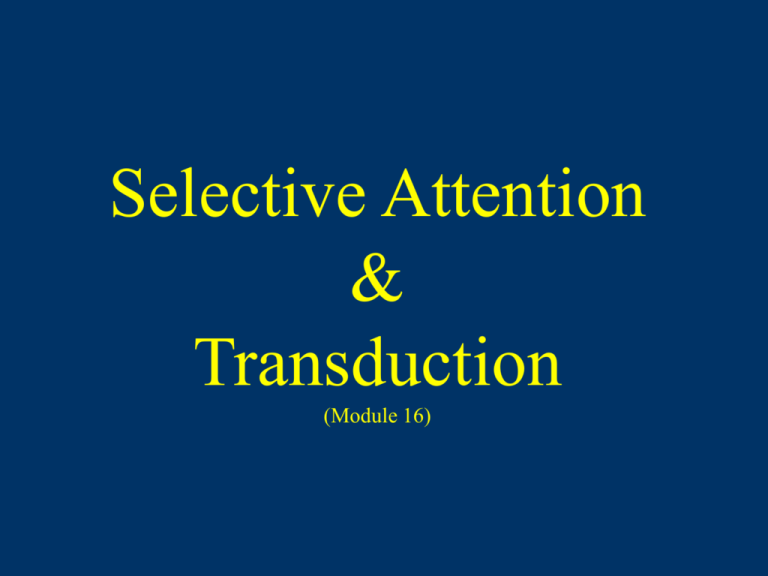
Selective Attention & Transduction (Module 16) Sensation • The process by which our sensory systems (eyes, ears, and other sensory organs) and nervous system receive/detect stimuli/info from the environment • A person’s awareness of the world through their senses. The Major Senses • There are 6 major senses – – – – – – vision hearing touch taste pain smell • The list can be extended with balance (vestibular sense), joint sense, body part position (kinesthetic sense) • Vision has been studied most extensively Sensation uses Bottom-Up Processing • Information processing that focuses on the raw material entering through the eyes, ears, and other organs of sensation • How we process info when we have NO PRIOR KNOWLEDGE Perception • How you make sense of your sensory information. • The process of selecting, organizing and interpreting sensory information • Draws upon our experience & expectations Perception uses Top-Down Processing • Information processing that focuses on expectations and prior experiences in interpreting incoming sensory information Detection Transduction Interpretation Bottom-Up vs. Top-Down Processing Follow the directions carefully! • Go to http://jeffmilner.com/backmasking.htm. Pick a song from the list and listen to it normally (play forward). • Now listen to it in reverse. DO NOT CLICK ON “SHOW REVERSE LYRICS” • Now listen to it in reverse again, this time “Show the Reverse Lyrics” • Can you hear the “secret” message? • Why couldn’t you hear it the first time you listened in reverse? – You had no expectations. Just heard sounds. This is Bottom-Up processing! • Why could you make out the “hidden message” when you could see the reverse lyrics? – When told what to listen for the task becomes TopDown processing! You are using your expectations! Selective Attention • Focusing conscious awareness on a particular stimulus to the exclusion of others • The ability to focus on one thing at a time • Allows a person to function in a world filled with many stimuli/distractions • People with ADHD have trouble doing this. Cocktail Party Effect • Demonstrates selective attention • If talking to one person in a crowded noisy room you will still notice if someone says your name. • This demonstrates that even though you weren’t paying attention to something your brain was still monitoring other sensual information in the room and alerting you when there was something you needed to pay attention to. Read the following words to yourself •Did you notice that the word “the” was written twice? •If not, it shows how your brain was selectively paying attention to the meaning of what you were reading and not what was actually written. •Example of Top-Down Processing Multitasking • Are we good at Multitasking? NO! • Try to do the following activity? How well could you attend to the multiple stimuli at once? • The Stroop Effect • NY Times Distracted Driving Simulator Inattentive Blindness • We are only able to pay attention to a tiny sliver of visual stimuli. Things outside our attention we are blind to • Caused by our amazing focus on just some parts of the environment. • Change Blindness – Failure to notice changes in the environment…sometimes obvious ones. Watch these Person Swaps • Choice Blindness – Not noticing when your preferred choice has changed – Jam Swap or Face Swap Selective Attention: An Example • View this updated version of Neisser’s Selective Attention Test basketball video clip below. Count the number of passes made by the girls in white. (click HERE to start) Did you notice the lady walk across the room with the umbrella? No! You were too busy watching & counting the passes. Try these: http://www.dothetest.co.uk/
